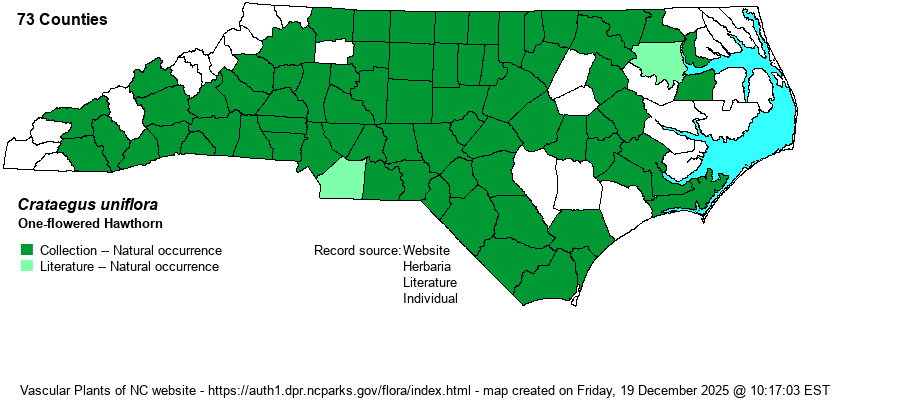| Author | Muenchhausen | |
| Distribution | Throughout the Piedmont, the western and central Coastal Plain, and the lower Mountains. Rare to absent from the higher Mountains and most of the far eastern counties. Essentially present in all Piedmont counties and in most of the western and southern Coastal Plain counties.
NC lies near the center of the range, occurring north to NY and MO, and south to central FL and eastern TX.
| |
| Abundance | Common over the Piedmont and western half (and southern) Coastal Plain; uncommon in the eastern half of the Coastal Plain, and rare to absent toward the Tidewater region. Fairly common in lower Mountain elevations in the southern and central counties, but mostly scarce to absent in the northern counties. It is the only hawthorn in the state given an S5 state rank by the NCNHP. | |
| Habitat | The species occurs mainly in dry or xeric soils of thickets, open upland woods, wooded edges, and fencerows. |
| Phenology | Blooms in April and May, and fruits in September and October. | |
| Identification | This is a very familiar species to most observers, and thus should be easily identified by the inflorescence usually (but not always) consisting of just a single flower or fruit. It is mainly a medium to rarely a large deciduous shrub, growing to about 3-6 feet tall. The leaves tend to be quite consistent from leaf to leaf and shrub to shrub, being obovate with a long and gradually narrowed, cuneate base. The outer margin is moderately toothed and rounded, but seldom are lobes present. The thorns are rather slender, often to 2 inches long and can appear quite needle-like. In addition to the normally single flower and fruit per inflorescence, the sepals of the calyx remain on the fruit, giving the fruit a “leafy” look. Though a number of hawthorns have leaves that are rather similar to this one, C. uniflora is the one you are most likely to encounter in the Piedmont and Coastal Plain in dry soil, though you do need to check for single flowers and fruit, to rule out less numerous species. | |
| Taxonomic Comments | Though the nominate variety is the common one in the state, Lance (2014) lists var. brittonii as being in the state. Weakley (2018) and a few other recent references have split out this taxon as a full species – C. brittonii.
| |
| Other Common Name(s) | Dwarf Hawthorn (used here and in several other references for C. munda). | |
| State Rank | S5 | |
| Global Rank | G5 | |
| State Status | | |
| US Status | | |
| USACE-agcp | | |
| USACE-emp | | |

